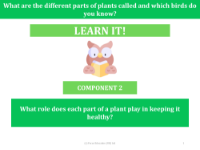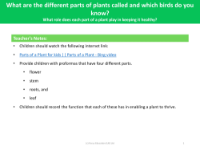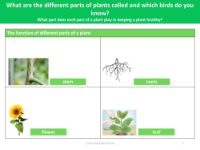What is the function of each part of a plant? - Plant - Year 1

Science Resource Description
Understanding the various functions of plant parts is fundamental for Year 1 students learning about botany. Each component of a plant plays a crucial role in its growth and survival. The leaves are the plant's food factories, where photosynthesis occurs, converting sunlight into energy. The stem acts as the plant's backbone, providing support and transporting nutrients and water between the roots and leaves. Roots anchor the plant in the soil, absorb water and minerals, and sometimes store food. Lastly, the flower is the reproductive part of the plant, often attracting pollinators with its color and scent, which is vital for the production of seeds.
To ensure a plant grows healthy, it requires several essential conditions. Firstly, it needs sunlight, which is used by the leaves for photosynthesis. Water is also crucial, absorbed through the roots, it helps to keep the plant hydrated and transports nutrients. Nutrient-rich soil provides the necessary minerals for the plant's growth. Lastly, air is needed, particularly carbon dioxide, which is used in photosynthesis to produce oxygen and glucose. A balance of these four elements contributes to a plant's overall health and vitality.




